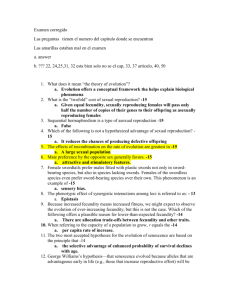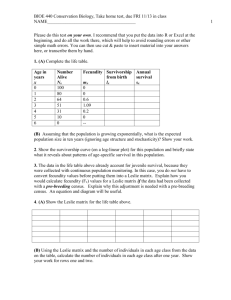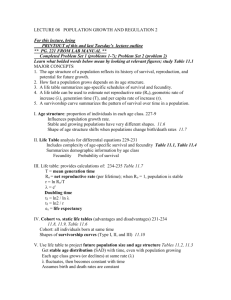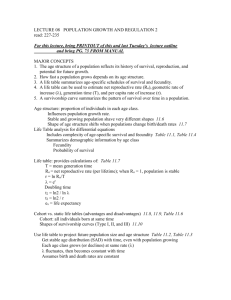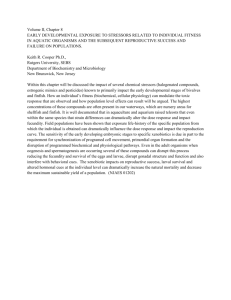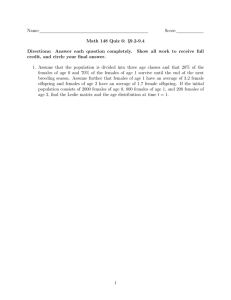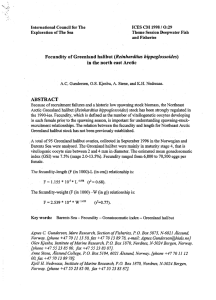CM 1998 /0: 16 International Council for the Theme Session (0) on Deepwater
advertisement
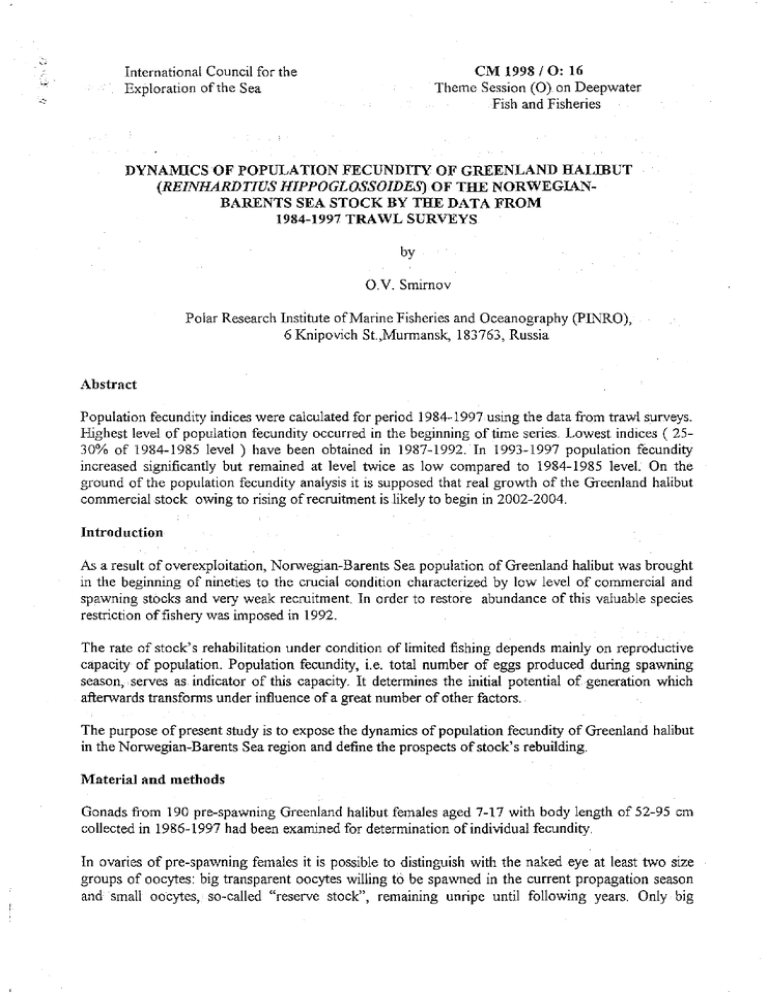
.... -, CM 1998 /0: 16 Theme Session (0) on Deepwater Fish and Fisheries International Council for the Exploration of the Sea DYNAMICS OF POPULATION FECUNDITY OF GREENLAND HALffiUT (REINHARDTIUS HIPPOGLOSSOIDES) OF THE NORWEGIANBARENTS SEA STOCK BY THE DATA FROM 1984-1997 TRAWL SURVEYS by O.V. Smirnov Polar Research Institute of Marine Fisheries and Oceanography (pINRO), 6 Knipovich St.,Munnansk, 183763, Russia Abstract Population fecundity indices were calculated for period 1984-1997 using the data from trawl surveys. Highest level of population fecundity occurred in the beginning of time series. Lowest indices ( 2530% of 1984-1985 level) have been obtained in 1987-1992. In 1993-1997 population fecundity increased significantly but remained at level twice as low compared to 1984-1985 level. On the ground of the population fecundity analysis it is supposed that real growth of the Greenland halibut commercial stock owing to rising of recruitment is likely to begin in 2002-2004. Introduction As a result of overexploitation, Norwegian-Barents Sea population of Greenland halibut was brought in the beginning of nineties to the crucial condition characterized by low level of commercial and spawning stocks and very weak recruitment. In order to restore abundance of this valuable species restriction of fishery was imposed in 1992. The rate of stock's rehabilitation under condition of limited fishing depends mainly on reproductive capacity of population. Population fecundity, i.e. total number of eggs produced during spawning season, serves as indicator of this capacity. It determines the initial potential of generation which afterwards transfonns under influence of a great number of other factors. The purpose of present study is to expose the dynamics of population fecundity of Greenland halibut in the Norwegian-Barents Sea region and define the prospects of stock's rebuilding. Material and methods Gonads from 190 pre-spawning Greenland halibut females aged 7-17 with body length of 52-95 cm collected in 1986-1997 had been examined for determination of individual fecundity. In ovaries of pre-spawning females it is possible to distinguish with the naked eye at least two size groups of oocytes: big transparent oocytes willing to be spawned in the current propagation season and small oocytes, so-called "reserve stock", remaining unripe until following years. Only big ------------------------ 2 oocytes were counted. Oocytes calculated in 2-3 pieces ( each of 5-10 g ) taken from different parts of ovary with subsequent re-calculation according to its total mass. On the base of data obtained average individual fecundities of fish from different age and length groups were computed. Since ovaries of fish smaller than 50 cm are absent in collection, the average fecundity of such fish is admitted to be equal 8 thou. eggs. Average fecundity of females from length group 86-90 cm is got as average between adjacent groups. Abundance indices of mature females were received from trawl surveys data. Surveys were conducted in October-December 1984-1997 in the area of 140 thou. sq. miles from Norwegian coast to 80 N at West Spitsbergen and from 900 m isobath on the slope of the continental shelf to 36°30 E ( Fig. 1 ). Unfortunately, in 1996 only western part of area with depth more than 400 m was covered. 0 Population fecundity ( PF ) was calculated as: k PF - 2::nifi where i=l n i-abundance index of mature females from length (age) group i; fi - average individual fecundity offemales from length (age) group i; k - number oflength (age) groups. It is known that mature females of Greenland halibut sometimes miss spawning (Fedorov; 1971). Besides, some females spawn at places allocated far from the main spawning sites (for example the Murman Bank) where eggs have a little chance to be fertilized because of poor concentration of spermatozoa. These factors were not taken into account since both of them demand more detailed annual observations. Results and discussion Maturation of Greenland halibut females In 1984-1997 mature specimens were found among females starting from age 4-5 years and length 45 cm. It seems however that portion of such fast-matured females was negligible therefore they were caught very rare. Similar results had been obtained in 1971-1984 (Kovtsova and Nizovtsev, 1985). Special histological studies carried out in spring 1998 showed that females reached maturity mainly at length 50-63 em. As have been revealed by long - period observations, the mass maturation of females began at age 7 years at length more than 55 em. At present 50% females reach maturity at age 8 years at length about 60 em ( Fig. 2 ). Immature specimens older than 13 years and longer than 77 cm had not been registered in 1984-1997. Individual fecundity Studies of ovaries showed that individual fecundity of Greenland halibut females from NorwegianBarents Sea.population varied in wide range from 6.4 to 94.4 thou. eggs. Significant variability of .,.. 3 fecundity was observed not only in females of different age and length, but also in females of the same age or length group (Fig.3). Nevertheless, trend towards the individual fecundity growth together with increase of body size and age was quite obvious. Average fecundity of largest and eldest females was much more than fecundity of small young fish ( Tables 1,2 ). Dependence of eggs quality (amount and structure of yolk, fertilization ability etc.) from body length or age of Greenland halibut spawners is still not investigated. But by analogy with other fish species (Vladimirov et al.,1965; Cheprakova, 1965) it is possible to suppose that eggs produced by middlesized (middle-aged) repeat-spawning specimens at length of 60-80 em ( aged 8-14 ) have highest qualitative indices compared to first-time spawning or eldest females. Correlation of individual fecundity with body length was found higher than with age (r=0.79 and 0.60 respectively). It is in accordance with results of previous studies (Bowering, 1980; Djakov, 1982) and with existing conception on paramount body size influence on beginning of maturation and individual fecundity. Therefore, mainly results of calculations based on length composition of mature females and fecundity-at-Iength data represented below. Indices of abundance and population fecundity Investigations revealed that in 1984-1997 middle-sized (61-80 cm) specimens constituted on average 71% of mature females and produced 77% of eggs. Table 3 shows that in 1984-1985 abundance of mature females was comparatively high (13-16 mill.). Afterwards abrupt decline and stabilization in 1987-1992 at low level (4-5. mill.) were registered. Number of most important middle-sized spawners by 1989 was 4.0-4.7 times as small compared to 1984-1985 level. Growth of the portion of first-time spawners ( smaller than 60 cm ) from 20% in 1984 to 30-35% in 1988-1991 occurred at the same time. Reduction of total number of spawners and change of ratio of different size groups led to drop in population fecundity (Table 4). Minimum level of population fecundity was observed in 1989-1992 (25-30% of the 1984-1985 level). It is probably an explanation of disappearance of young Greenland halibut in the beginning of nineties (Hylen and Nedreaas, 1995). Rise of abundance of mature females up to 7-8 millions was marked in 1993-1994. This increase had been conditioned not only by lowering of catches but also by mass maturation of females from relatively numerous 1984-1986 year-classes. It had a beneficial effect on population fecundity which significantly augmented to the level about twice as high compared to 1989-1992 level (Table 4). It is difficult to realize results which had been got in 1995. In spite of growth of total abundance of Greenland halibut from 1994 to 1995 (Smirnov, 1996), the number of mature females dropped again. In some extent it was probably caused by activization oflong-line fisheries in 1995 (Anon., 1998) and weak recruitment consisted of females only from poor year-classes though underestimation evidently was the basic reason. The data from 1996 are not valid for comparison because only part of standard area was surveyed in that year. Indices of abundance of mature females and popUlation fecundity in 1997 were similar to indices obtained in 1993-1994 (Tables 3,4). 4 On the basis of observations with the exception of results from 1995 it is possible to conclude that in the period from 1993 to 1997 abundance of mature females and population fecundity stabilized at level twice as high compared to 1989-1992 but twice as low compared to 1984-1985 level. Such stability sign'ified that the number of young females which had matured was approximately equal to the number of mature females which had been caught at the same time. Examination of the data on landings (Anon.,1998) and composition of catches taken by different gears (Huse et.al., 1997) disclosed that about l.5 - 2 millions of mature females had been annually caught in 1992-1996. If only the regulation measur~ had been stronger especially with respect to long-line fishery, population fecundity at that period would be higher at least by.l0-15%. Conclusion Analysis of the population fecundity dynamics demonstrates that the state of Norwegian-Barents Sea population of Greenland halibut gradually becomes better. But the restoring process is very slow due to some reasons. On the one hand restrictions were put on fishery too late. It should have been done as long ago as in 1988-1989. Also increase of the mature females number in 1992-1997 was restrained by fishery in the considerable degree. On the other hand lingering restoration connects with prolonged period of females· maturation and rather low individual fecundity of young spawners formed significant part of reproductive stock in the beginning of nineties. Increase in Greenland halibut abundance on the spawning grounds in the area of the slope of the continental shelf marked in 1992-1996 by vessels rented for trial fishing (Anon., 1998) was caused by accumulation ofmales maturated faster than females. Under existing conditions the increase of the population fecundity should be expected in 1999-2000 when females born in 1993-1994 would reach maturity. Consequently, real growth of the Greenland halibut commercial stock owing to the rising of recruitment is likely to begin in 2002-2004. References Anon., 1998. Report of the Arctic Fisheries Working Group. ICES CM 1998/ Assess:2. 366pp. Bowerimr.W.R. 1980. Fecundity of .Greenland halibut, Reinhardtiushippoglossoides (Walbaum), from southern Labrador and the southeastern Gulf of St. Lawrence. 1. Northw. At!. Fish. Sci., 1: 3943. Cheprakova, Yu.I. 1965. Change of qualitative indices of eggs during repeated spawning. Theoreticalfundamentals offish-breeding. Moscow. Nauka. 1965. p. 73-76. (ill Russian). Djakov, Yu.P. 1982. Fecundity of Greenland halibut, Reinhardtius hippoglossoides (WaJbaum), (Pleuronectidae), from the Bering Sea. 1. Ichthyol. 22(5}: p. 789-794. (in RUSSian). Fedorov, K.E. 1971. Condition of gonads of Greenland halibut from the Barents Sea in connection with missing of spawning. 1. Ichthyol. v.11 (5/50): p. 785-793. (in RUSSian). 5 Huse,I" Nedreaas,KH" Gundersen, A. C. 1997. Effect of fishing strategy on relative selectivity in trawls, longline and gillnets on Greenland halibut. Gear selection and sampling gear, Proceedings of the seventh IMR-PINRO Symposium. Murmansk, 23-24 June 1997: p. 107-119. Hylen, A. and Nedreaas, KH. 1995. Pre-recruit studies of the North-east arctic Greenland halibut stock. Precision and relevance of pre-recn.tit studies for fishery management related to fish stocks in the Barents Sea and adjacent waters, Proceedings of the sixth IMR-PINRO Symposium. Bergen, 14-17 June 1994,: p. 229-237, Kovtsova, M. V. and Nizovtsev, G.P. 1985. Peculiarities of growth and maturation of Greenland halibut of the Norwegian-Barents Sea stock in 1971-1984. ICES CM 19851 G:7 (Sess.S), 17pp, Vladimirov, V.I" Semenov, KI. and Zhukinsky, V.N. 1965. Quality of parents and viability of posterity in earlier stages of life history of some fish. Theoretical fundamentals of fish-breeding. Moscow. Nauka. 1965. p. 19-32. (in Russian). -. 6 Table 1. Greenland halibut: average fecundity by age groups (1986-1997 data combined) Age, years 6 7 8 9 10 11 12 13 14 15 16 17 Total Table 2. Greenland halibut: average fecundity by length groups (1986-1997 data combined) Average fecundity Number of observations - - 15721 18766 22071 25505 32484 34247 38261 46101 5 20 33 45 17 14 7 1 - - Length, cm 45-50 51-55 56-60 61-65 66-70 71-75 76-80 81-85 86-90 91-95 75344 47250 2 1 Total Average fecundity Number of observations - - 10144 12899 17521 26107 30217 42258 59232 7 18 43 62 30 21 7 - - 70841 2 190 145 , . 7 Length, cm ::;50 51-55 56-60 61-65 66-70 71-75 76-80 81-85 86-90 91-95 >95 Total Length, cm Table 3. Greenland halibut: Abundauce indices of mature females from 1984-1997 trawl syrveys _. -_.. _-_. - .. - .. _----_._--- Years 1984 I 1985 I 1986 I 1987 I 1988 I 1989 I 1990 I 1991 I 1992 I 1993 I 1994 I 1995 I 1996* I 1997 350 . 591 208 269 126 441 131 192 155 220 218 512 950 77 450 493 197 61 67 507 802 37 300 282 2294 2965 1756 624 1040 596 925 1302 170 1567 893 721 948 1214 4141 4600 2217 1332 1508 877 1550 1970 1249 2204 2593 1615 1444 2412 3323 3657 2404 1290 1198 914 489 587 1450 1791 1854 1490 1009 2465 1776 2014 1319 645 511 415 312 163 502 859 772 579 846 573 1128 1012 440 481 361 200 115 122 182 269 188 187 269 297 262 382 89 245 234 107 25 26 99 102 72 50 16 179 138 155 61 15 71 62 58 106 7 31 23 11 7 83 49 81 53 36 102 36 16 II 21 60 6 38 117 3 13713 16029 9499 4324 5069 5535 3838 4359 3875 6848 4711 4835 7649 7882 Table 4. Greenland halibut: Contributions of different length groups to population fecundity in 1984-1997 _.- -----,"- - - Years . 1984 I 2800 2211 29590 72554 86754 53665 47667 15519 8975 5880 1985 I 4728 5194 38246 80597 95473 60857 42765 22627 10081 5738 4250 325615 370556 1986 I 1664 9637 22651 38844 62761 39856 18594 5272 3967 3471 425 207142 1987 I 2152 781 8049 23338 33678 19490 20326 14512 976 3755 2692 129749 1988 I 1008 4665 13415 26422 31276 15441 15255 13860 4618 2550 1989 I 3528 5001 7188 15366 23862 12540 8452 6338 4032 7226 8288 128410 102321 . 1990 I 1048 1998 11931 27158 12766 9428 4860 1481 3772 2550 1991 I 1992 I 1993 I 1994 I 1995 I 1996* I 1997 1240 1536 1760 619 5143 8135 375 3043 2861 2193 11519 20213 9300 12228 15659 21884 38616 45432 28296 25300 42261 37855 46758 48402 38899 26342 64354 15169 25956 23328 17496 25564 17314 7691 11367 7945 7902 11367 12551 5864 6042 4265 2962 948 10603 455 2016 1496 715 455 779 1488 213 Total 76992 92970 148953 159995 107433 105005 167818, * only area of the slope of the continental shelf was investigated ( depth more than 400 m ). ::;50 51-55 56-60 61-65 66-70 71-75 76-80 81-85 86-90 91-95 >95 680 16794 34516 15325 4925 5155 1540 6894 1133 86962 8 ..",.- ". <0- A F " 20° Fig.!. Standard snrveyed area 9 ~ 100 100 SO 50 0 0 3 5 7 9 11 Age, years 13 15 -'"'" -,. -i? -'" - '7 '" " '" '1' '" '; t- '"Length groups, em ::!'"oo '" ~ '" Fig. 2. Ratio of mature females iu different age (A) and length (B) groups in 1984-1997 ( combined data ). 100000 100000 • R' =0,3653 90000 R' =0,6487 90000 80000 70000 • "" " I S 50000 :g 40000 ..." 30000 70000 • 60000 § • 80000 • I •• • • 0 20000 10000 0 6 7 8 • • • • I I • I I • 60000 • • 40000 30000 a 9 10 11 12 13 14 15 16 17 18 Age, years • 50000 20000 10000 • 0 45 50 55 60 65 70 75 80 85 90 95 100 Length, em Fig. 3. Individual fecundity of Greenland halibut from different age (A) and length (B) groups
